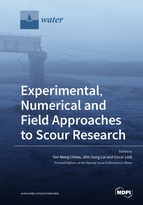Experimental, Numerical and Field Approaches to Scour Research
A special issue of Water (ISSN 2073-4441). This special issue belongs to the section "Water Erosion and Sediment Transport".
Deadline for manuscript submissions: closed (31 August 2019) | Viewed by 60966
Special Issue Editors
Interests: Scour, Sediment Transport, Turbulence, Seepage Effects, Structural Dynamics and Flow Interactions
Interests: bridge scour, sediment transport, monitoring and measurement, sensing network; flood inundation; river hydraulics
Special Issue Information
Dear Colleagues,
Scientific research in the area of scour around hydraulic structures started around the middle of the 20th century. These works were primarily empirical in nature and founded on laboratory experiments because of the complexity of the flow–sediment–structure interactions. The pure laboratory empiricism of the earlier works has since been complemented by both numerical and field approaches, especially since numerical software and field measurement devices have attained a significantly higher level of sophistication. The three-pronged-approach towards scour research has provided new insights into this interesting topic, including not only the original bridge foundation scour but also propeller, submarine pipeline, monopile, jet, rock, river bank and levee scour, etc. The overall objective of this Special Issue is to present innovative research based on any one or a combination of these approaches. New knowledge is presented to elucidate the physics of the topic and provide solutions to practitioners, thus offering a better framework to aid the decision-making processes of river, coastal and offshore engineers. Contributions to this Special Issue relating to the study of the effect of turbulence on and dynamic behavior of the structures will be of great value for both academia and stakeholders. Finally, a collection of innovative papers that explore the wide spectrum of subjects relating to scour in one issue of the journal will be an indispensable platform for future research.
Prof. Yee-Meng Chiew
Prof. Jihn-Sung Lai
Prof. Oscar Link
Guest Editors
Manuscript Submission Information
Manuscripts should be submitted online at www.mdpi.com by registering and logging in to this website. Once you are registered, click here to go to the submission form. Manuscripts can be submitted until the deadline. All submissions that pass pre-check are peer-reviewed. Accepted papers will be published continuously in the journal (as soon as accepted) and will be listed together on the special issue website. Research articles, review articles as well as short communications are invited. For planned papers, a title and short abstract (about 100 words) can be sent to the Editorial Office for announcement on this website.
Submitted manuscripts should not have been published previously, nor be under consideration for publication elsewhere (except conference proceedings papers). All manuscripts are thoroughly refereed through a single-blind peer-review process. A guide for authors and other relevant information for submission of manuscripts is available on the Instructions for Authors page. Water is an international peer-reviewed open access semimonthly journal published by MDPI.
Please visit the Instructions for Authors page before submitting a manuscript. The Article Processing Charge (APC) for publication in this open access journal is 2600 CHF (Swiss Francs). Submitted papers should be well formatted and use good English. Authors may use MDPI's English editing service prior to publication or during author revisions.
Keywords
- Scour
- Sediment Transport
- Turbulence
- River
- Coastal
- Offshore








